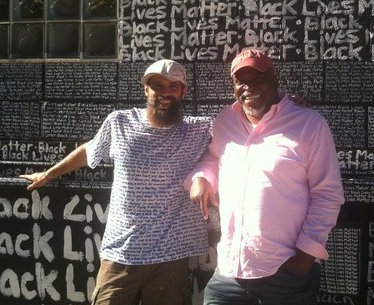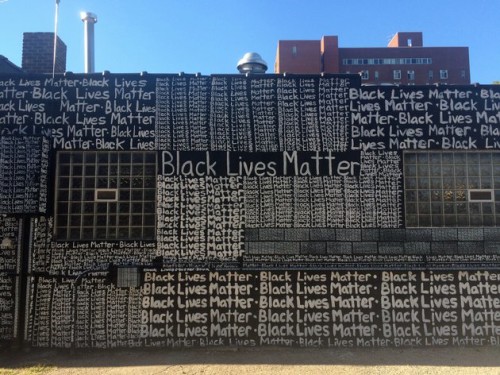A White Artist Wrote ‘Black Lives Matter’ 2,000 Times. But His Mural Almost Said ‘All Lives Matter.’
Share
Explore Our Galleries
Breaking News!
Today's news and culture by Black and other reporters in the Black and mainstream media.
Ways to Support ABHM?
By Kate Abbey-Lambertz, Huffington Post
Artist Renda Writer wrote “Black Lives Matter” about 2,000 times last week on a wall in Detroit, the white text in his handwriting appearing both tiny, streaming over the black background, and huge, shouting its message to anyone who walks by.
Writer, a white painter and poet from Miami, was commissioned by Detroit’s N’Namdi Center for Contemporary Art to create the mural. He worked on the piece for about 80 hours and finished earlier this week.
Gallery owner George N’Namdi said he wanted to spark dialogue and pay homage to the Black Lives Matter movement, which formed in response to police shootings of young black men and addresses racial inequality more broadly. But initially, he and the artist discussed incorporating the phrase “Lives Matter” or “All Lives Matter.”
Though the obvious meaning of “all lives matter” doesn’t contradict the assertion that black lives matter, some say changing the focus to “all lives” undermines the BLM movement and ignores its message that society doesn’t value black and white lives equally.

Artist and poet, Writer, with N’Nandi Gallery owner George N’Nandi. (N’nandi Center for Contemporary Art)
“All Lives Matter” has been used to criticize the movement’s tactics, appearing in Twitter fights, political speeches and more destructive scenarios. In July, a mural in Ottawa, Canada dedicated to a black woman who died in police custody was defaced, with the words “All Lives Matter” spray painted over her face. A Maryland church’s Black Lives Matter sign was vandalized twice this summer, with someone cutting out the first word.
“‘All Lives Matter’ really is a way of co-opting the Black Lives Matter movement,” N’Namdi told The Huffington Post. N’Namdi, who is black, ultimately decided that if Renda Writer included the words “All Lives Matter,” it would take away from the mural’s message.
“It really dawned on me, we’re talking about a movement here, we’re not talking about just a slogan,” N’Namdi continued. “We’re talking about something we’re trying to change, and once you start diluting the movement and making it ‘All Lives Matter’ … What issue is ‘All Lives Matter’ confronting? None.”
“I think ‘Black Lives Matter’ is a message of love,” he [Writer] said. “This particular race needs a little more attention, a little more love.”
Read the full article here.
Read more Breaking News here.












Comments Are Welcome
Note: We moderate submissions in order to create a space for meaningful dialogue, a space where museum visitors – adults and youth –– can exchange informed, thoughtful, and relevant comments that add value to our exhibits.
Racial slurs, personal attacks, obscenity, profanity, and SHOUTING do not meet the above standard. Such comments are posted in the exhibit Hateful Speech. Commercial promotions, impersonations, and incoherent comments likewise fail to meet our goals, so will not be posted. Submissions longer than 120 words will be shortened.
See our full Comments Policy here.